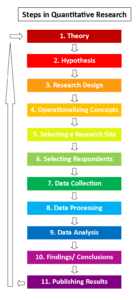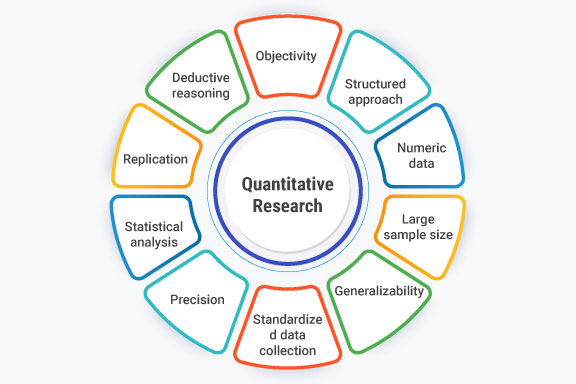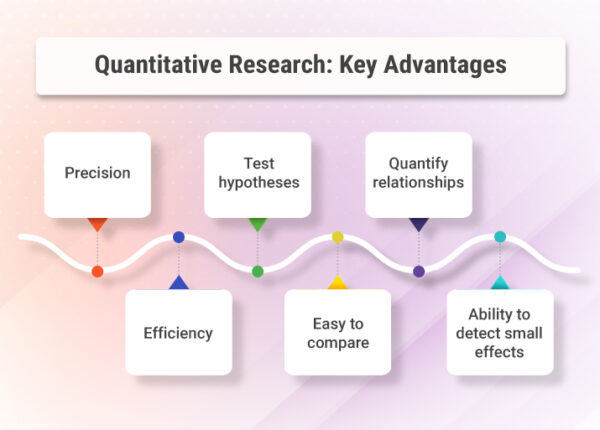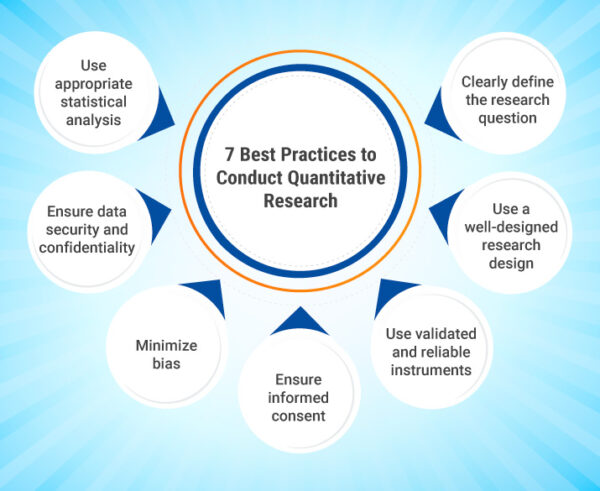- Privacy Policy

Home » Quantitative Research – Methods, Types and Analysis

Quantitative Research – Methods, Types and Analysis
Table of Contents
Quantitative research is a systematic investigation that primarily focuses on quantifying data, variables, and relationships. It involves the use of statistical, mathematical, and computational techniques to collect and analyze data. Quantitative research is often used to establish patterns, test hypotheses, and make predictions. It is widely applied in fields such as psychology, sociology, economics, health sciences, and education.

Quantitative Research
Quantitative research is a research approach that seeks to quantify data and generalize results from a sample to a larger population. It relies on structured data collection methods and employs statistical analysis to interpret results. This type of research is objective, and findings are typically presented in numerical form, allowing for comparison and generalization.
Key Characteristics of Quantitative Research :
- Objective : Focuses on numbers and measurable variables rather than subjective opinions.
- Structured : Employs well-defined research questions, hypotheses, and data collection methods.
- Statistical : Utilizes statistical tools to analyze data and validate findings.
- Replicable : Enables repetition of the study to verify results and increase reliability.
Example : A survey on the correlation between exercise frequency and stress levels among adults, using a Likert scale to measure responses.
Types of Quantitative Research
Quantitative research can be categorized into several types, each serving a specific purpose. The most common types include descriptive , correlational , experimental , and causal-comparative research.
1. Descriptive Research
Definition : Descriptive research describes characteristics or behaviors of a population without examining relationships or causes. It provides a snapshot of current conditions or attitudes.
Purpose : To gather information and create an overview of a particular phenomenon, population, or condition.
Example : A survey describing the demographics and academic performance of students at a university.
2. Correlational Research
Definition : Correlational research examines the relationship between two or more variables but does not imply causation. It analyzes patterns to determine if variables are associated or occur together.
Purpose : To identify associations or trends among variables without establishing cause and effect.
Example : Investigating the relationship between social media use and self-esteem among teenagers.
3. Experimental Research
Definition : Experimental research manipulates one or more independent variables to observe the effect on a dependent variable, establishing cause-and-effect relationships. This type of research involves control and experimental groups.
Purpose : To test hypotheses by isolating and controlling variables to establish causality.
Example : Testing the effect of a new medication on blood pressure by administering it to one group (experimental) and comparing it to a placebo group (control).
4. Causal-Comparative (Ex Post Facto) Research
Definition : Causal-comparative research investigates the cause-effect relationship between variables when experimental manipulation is not possible. It compares groups that differ on a particular variable to determine the effect of that variable.
Purpose : To explore cause-and-effect relationships retrospectively by comparing pre-existing groups.
Example : Studying the impact of different teaching methods on student performance by comparing classes taught with traditional versus technology-assisted instruction.
Quantitative Research Methods
Quantitative research methods focus on systematic data collection and analysis using structured techniques. Common methods include surveys , experiments , and observations .
Definition : Surveys are a popular quantitative method that involves asking participants standardized questions to collect data on their opinions, behaviors, or demographics. Surveys can be conducted via questionnaires, interviews, or online forms.
Purpose : To gather data from a large sample, allowing researchers to make inferences about the larger population.
Example : Conducting a survey to collect customer satisfaction data from a random sample of customers in a retail store.
Advantages :
- Cost-effective and time-efficient for large sample sizes.
- Provides structured data that is easy to analyze statistically.
Disadvantages :
- Limited depth, as responses are often restricted to specific options.
- Potential for response bias, where participants may not answer truthfully.
2. Experiments
Definition : Experiments involve manipulating one or more variables in a controlled environment to observe the effect on another variable. Experiments are often conducted in laboratories or controlled settings to maintain precision and limit external influences.
Purpose : To test hypotheses and establish cause-and-effect relationships.
Example : Conducting a laboratory experiment to test the effect of light exposure on sleep patterns.
- High level of control over variables.
- Establishes causality, which can support theory-building.
- Limited external validity, as findings may not always apply outside of the controlled setting.
- Ethical considerations may limit experimentation on certain subjects or groups.
3. Observations
Definition : Observational research involves systematically observing and recording behavior or events as they occur naturally, without interference. While often used in qualitative research, structured observational methods can yield quantitative data.
Purpose : To gather real-world data in a non-intrusive manner.
Example : Observing customer behavior in a store to track time spent in different areas and identify shopping patterns.
- Provides data on actual behaviors rather than self-reported responses.
- Useful for gathering data on situations where surveys or experiments may not be feasible.
- Observer bias may affect results.
- Can be time-consuming, especially if behaviors are infrequent or complex.
Data Collection Tools in Quantitative Research
Quantitative research relies on various tools to collect and quantify data, including:
- Questionnaires : Standardized forms with close-ended questions, often using scales (e.g., Likert scale) for responses.
- Tests and Assessments : Used to measure knowledge, skills, or other measurable attributes.
- Digital Tracking Tools : Software or digital applications that collect data, such as website traffic metrics or physiological monitoring devices.
Data Analysis in Quantitative Research
Data analysis in quantitative research involves statistical techniques to interpret numerical data and determine relationships or trends. Key techniques include descriptive statistics , inferential statistics , and correlation analysis .
1. Descriptive Statistics
Definition : Descriptive statistics summarize and organize data, providing basic information such as mean, median, mode, standard deviation, and range.
Purpose : To give an overview of the dataset, allowing researchers to understand general trends and distributions.
Example : Calculating the average test scores of students in a school to assess overall performance.
Common Measures :
- Mean : Average of all data points.
- Median : Middle value of an ordered dataset.
- Standard Deviation : Measure of variability around the mean.
2. Inferential Statistics
Definition : Inferential statistics allow researchers to make predictions or inferences about a population based on sample data. Techniques include hypothesis testing, t-tests, ANOVA, and regression analysis.
Purpose : To determine if observed results are statistically significant and can be generalized to a larger population.
Example : Using a t-test to compare average scores between two different teaching methods to see if one is significantly more effective.
Common Tests :
- t-Test : Compares the means of two groups to determine if they are statistically different.
- ANOVA (Analysis of Variance) : Compares means among three or more groups.
- Regression Analysis : Examines the relationship between independent and dependent variables.
3. Correlation Analysis
Definition : Correlation analysis measures the strength and direction of the relationship between two variables. It is used to determine if changes in one variable are associated with changes in another.
Purpose : To identify associations between variables without implying causation.
Example : Calculating the correlation coefficient between screen time and academic performance to determine if there is an association.
- Pearson Correlation Coefficient (r) : Measures linear correlation between two continuous variables.
- Spearman’s Rank Correlation : Measures correlation between two ranked variables.
Advantages and Disadvantages of Quantitative Research
- Objective : Minimizes researcher bias by focusing on numerical data.
- Generalizable : Findings from large, random samples can often be applied to a broader population.
- Replicable : Structured methods make it possible for other researchers to replicate studies and verify results.
Disadvantages
- Limited Depth : Quantitative research often lacks the depth of qualitative insights.
- Rigid Structure : Limited flexibility in data collection and analysis.
- Potential Bias : Response or sampling biases can affect results, especially in survey-based studies.
Tips for Conducting Effective Quantitative Research
- Define Clear Objectives : Develop specific research questions or hypotheses to guide the study.
- Choose the Right Method : Select a quantitative method that aligns with the research goals and type of data needed.
- Ensure Sample Representativeness : Use appropriate sampling techniques to ensure results can be generalized.
- Employ Proper Statistical Tools : Choose analysis techniques that match the nature of the data and research questions.
- Interpret Results Accurately : Avoid overgeneralizing findings and consider limitations when interpreting results.
Quantitative research provides a structured, objective approach to investigating research questions, allowing for statistical analysis, pattern recognition, and hypothesis testing. With methods like surveys, experiments, and observational studies, quantitative research offers valuable insights across diverse fields, from social sciences to healthcare. By applying rigorous statistical analysis, researchers can draw meaningful conclusions, contributing to the body of scientific knowledge and helping inform data-driven decisions.
- Creswell, J. W., & Creswell, J. D. (2018). Research Design: Qualitative, Quantitative, and Mixed Methods Approaches (5th ed.). SAGE Publications.
- Punch, K. F. (2014). Introduction to Social Research: Quantitative and Qualitative Approaches (3rd ed.). SAGE Publications.
- Field, A. (2013). Discovering Statistics Using IBM SPSS Statistics (4th ed.). SAGE Publications.
- Trochim, W. M., & Donnelly, J. P. (2008). The Research Methods Knowledge Base (3rd ed.). Cengage Learning.
- Babbie, E. R. (2021). The Practice of Social Research (15th ed.). Cengage Learning.
About the author
Muhammad Hassan
Researcher, Academic Writer, Web developer
You may also like

Phenomenology – Methods, Examples and Guide

Research Methods – Types, Examples and Guide

Mixed Methods Research – Types & Analysis

Exploratory Research – Types, Methods and...

Case Study – Methods, Examples and Guide

Qualitative Research Methods
Qualitative vs Quantitative Research Methods & Data Analysis
Saul McLeod, PhD
Editor-in-Chief for Simply Psychology
BSc (Hons) Psychology, MRes, PhD, University of Manchester
Saul McLeod, PhD., is a qualified psychology teacher with over 18 years of experience in further and higher education. He has been published in peer-reviewed journals, including the Journal of Clinical Psychology.
Learn about our Editorial Process
Olivia Guy-Evans, MSc
Associate Editor for Simply Psychology
BSc (Hons) Psychology, MSc Psychology of Education
Olivia Guy-Evans is a writer and associate editor for Simply Psychology. She has previously worked in healthcare and educational sectors.
The main difference between quantitative and qualitative research is the type of data they collect and analyze.
Quantitative data is information about quantities, and therefore numbers, and qualitative data is descriptive, and regards phenomenon which can be observed but not measured, such as language.
- Quantitative research collects numerical data and analyzes it using statistical methods. The aim is to produce objective, empirical data that can be measured and expressed numerically. Quantitative research is often used to test hypotheses, identify patterns, and make predictions.
- Qualitative research gathers non-numerical data (words, images, sounds) to explore subjective experiences and attitudes, often via observation and interviews. It aims to produce detailed descriptions and uncover new insights about the studied phenomenon.
On This Page:
What Is Qualitative Research?
Qualitative research is the process of collecting, analyzing, and interpreting non-numerical data, such as language. Qualitative research can be used to understand how an individual subjectively perceives and gives meaning to their social reality.
Qualitative data is non-numerical data, such as text, video, photographs, or audio recordings. This type of data can be collected using diary accounts or in-depth interviews and analyzed using grounded theory or thematic analysis.
Qualitative research is multimethod in focus, involving an interpretive, naturalistic approach to its subject matter. This means that qualitative researchers study things in their natural settings, attempting to make sense of, or interpret, phenomena in terms of the meanings people bring to them. Denzin and Lincoln (1994, p. 2)
Interest in qualitative data came about as the result of the dissatisfaction of some psychologists (e.g., Carl Rogers) with the scientific study of psychologists such as behaviorists (e.g., Skinner ).
Since psychologists study people, the traditional approach to science is not seen as an appropriate way of carrying out research since it fails to capture the totality of human experience and the essence of being human. Exploring participants’ experiences is known as a phenomenological approach (re: Humanism ).
Qualitative research is primarily concerned with meaning, subjectivity, and lived experience. The goal is to understand the quality and texture of people’s experiences, how they make sense of them, and the implications for their lives.
Qualitative research aims to understand the social reality of individuals, groups, and cultures as nearly as possible as participants feel or live it. Thus, people and groups are studied in their natural setting.
Some examples of qualitative research questions are provided, such as what an experience feels like, how people talk about something, how they make sense of an experience, and how events unfold for people.
Research following a qualitative approach is exploratory and seeks to explain ‘how’ and ‘why’ a particular phenomenon, or behavior, operates as it does in a particular context. It can be used to generate hypotheses and theories from the data.
Qualitative Methods
There are different types of qualitative research methods, including diary accounts, in-depth interviews , documents, focus groups , case study research , and ethnography .
The results of qualitative methods provide a deep understanding of how people perceive their social realities and in consequence, how they act within the social world.
The researcher has several methods for collecting empirical materials, ranging from the interview to direct observation, to the analysis of artifacts, documents, and cultural records, to the use of visual materials or personal experience. Denzin and Lincoln (1994, p. 14)
Here are some examples of qualitative data:
Interview transcripts : Verbatim records of what participants said during an interview or focus group. They allow researchers to identify common themes and patterns, and draw conclusions based on the data. Interview transcripts can also be useful in providing direct quotes and examples to support research findings.
Observations : The researcher typically takes detailed notes on what they observe, including any contextual information, nonverbal cues, or other relevant details. The resulting observational data can be analyzed to gain insights into social phenomena, such as human behavior, social interactions, and cultural practices.
Unstructured interviews : generate qualitative data through the use of open questions. This allows the respondent to talk in some depth, choosing their own words. This helps the researcher develop a real sense of a person’s understanding of a situation.
Diaries or journals : Written accounts of personal experiences or reflections.
Notice that qualitative data could be much more than just words or text. Photographs, videos, sound recordings, and so on, can be considered qualitative data. Visual data can be used to understand behaviors, environments, and social interactions.
Qualitative Data Analysis
Qualitative research is endlessly creative and interpretive. The researcher does not just leave the field with mountains of empirical data and then easily write up his or her findings.
Qualitative interpretations are constructed, and various techniques can be used to make sense of the data, such as content analysis, grounded theory (Glaser & Strauss, 1967), thematic analysis (Braun & Clarke, 2006), or discourse analysis .
For example, thematic analysis is a qualitative approach that involves identifying implicit or explicit ideas within the data. Themes will often emerge once the data has been coded .

Key Features
- Events can be understood adequately only if they are seen in context. Therefore, a qualitative researcher immerses her/himself in the field, in natural surroundings. The contexts of inquiry are not contrived; they are natural. Nothing is predefined or taken for granted.
- Qualitative researchers want those who are studied to speak for themselves, to provide their perspectives in words and other actions. Therefore, qualitative research is an interactive process in which the persons studied teach the researcher about their lives.
- The qualitative researcher is an integral part of the data; without the active participation of the researcher, no data exists.
- The study’s design evolves during the research and can be adjusted or changed as it progresses. For the qualitative researcher, there is no single reality. It is subjective and exists only in reference to the observer.
- The theory is data-driven and emerges as part of the research process, evolving from the data as they are collected.
Limitations of Qualitative Research
- Because of the time and costs involved, qualitative designs do not generally draw samples from large-scale data sets.
- The problem of adequate validity or reliability is a major criticism. Because of the subjective nature of qualitative data and its origin in single contexts, it is difficult to apply conventional standards of reliability and validity. For example, because of the central role played by the researcher in the generation of data, it is not possible to replicate qualitative studies.
- Also, contexts, situations, events, conditions, and interactions cannot be replicated to any extent, nor can generalizations be made to a wider context than the one studied with confidence.
- The time required for data collection, analysis, and interpretation is lengthy. Analysis of qualitative data is difficult, and expert knowledge of an area is necessary to interpret qualitative data. Great care must be taken when doing so, for example, looking for mental illness symptoms.
Advantages of Qualitative Research
- Because of close researcher involvement, the researcher gains an insider’s view of the field. This allows the researcher to find issues that are often missed (such as subtleties and complexities) by the scientific, more positivistic inquiries.
- Qualitative descriptions can be important in suggesting possible relationships, causes, effects, and dynamic processes.
- Qualitative analysis allows for ambiguities/contradictions in the data, which reflect social reality (Denscombe, 2010).
- Qualitative research uses a descriptive, narrative style; this research might be of particular benefit to the practitioner as she or he could turn to qualitative reports to examine forms of knowledge that might otherwise be unavailable, thereby gaining new insight.
What Is Quantitative Research?
Quantitative research involves the process of objectively collecting and analyzing numerical data to describe, predict, or control variables of interest.
The goals of quantitative research are to test causal relationships between variables , make predictions, and generalize results to wider populations.
Quantitative researchers aim to establish general laws of behavior and phenomenon across different settings/contexts. Research is used to test a theory and ultimately support or reject it.
Quantitative Methods
Experiments typically yield quantitative data, as they are concerned with measuring things. However, other research methods, such as controlled observations and questionnaires , can produce both quantitative information.
For example, a rating scale or closed questions on a questionnaire would generate quantitative data as these produce either numerical data or data that can be put into categories (e.g., “yes,” “no” answers).
Experimental methods limit how research participants react to and express appropriate social behavior.
Findings are, therefore, likely to be context-bound and simply a reflection of the assumptions that the researcher brings to the investigation.
There are numerous examples of quantitative data in psychological research, including mental health. Here are a few examples:
Another example is the Experience in Close Relationships Scale (ECR), a self-report questionnaire widely used to assess adult attachment styles .
The ECR provides quantitative data that can be used to assess attachment styles and predict relationship outcomes.
Neuroimaging data : Neuroimaging techniques, such as MRI and fMRI, provide quantitative data on brain structure and function.
This data can be analyzed to identify brain regions involved in specific mental processes or disorders.
For example, the Beck Depression Inventory (BDI) is a clinician-administered questionnaire widely used to assess the severity of depressive symptoms in individuals.
The BDI consists of 21 questions, each scored on a scale of 0 to 3, with higher scores indicating more severe depressive symptoms.
Quantitative Data Analysis
Statistics help us turn quantitative data into useful information to help with decision-making. We can use statistics to summarize our data, describing patterns, relationships, and connections. Statistics can be descriptive or inferential.
Descriptive statistics help us to summarize our data. In contrast, inferential statistics are used to identify statistically significant differences between groups of data (such as intervention and control groups in a randomized control study).
- Quantitative researchers try to control extraneous variables by conducting their studies in the lab.
- The research aims for objectivity (i.e., without bias) and is separated from the data.
- The design of the study is determined before it begins.
- For the quantitative researcher, the reality is objective , exists separately from the researcher, and can be seen by anyone.
- Research is used to test a theory and ultimately support or reject it.
Limitations of Quantitative Research
- Context : Quantitative experiments do not take place in natural settings. In addition, they do not allow participants to explain their choices or the meaning of the questions they may have for those participants (Carr, 1994).
- Researcher expertise : Poor knowledge of the application of statistical analysis may negatively affect analysis and subsequent interpretation (Black, 1999).
- Variability of data quantity : Large sample sizes are needed for more accurate analysis. Small-scale quantitative studies may be less reliable because of the low quantity of data (Denscombe, 2010). This also affects the ability to generalize study findings to wider populations.
- Confirmation bias : The researcher might miss observing phenomena because of focus on theory or hypothesis testing rather than on the theory of hypothesis generation.
Advantages of Quantitative Research
- Scientific objectivity : Quantitative data can be interpreted with statistical analysis, and since statistics are based on the principles of mathematics, the quantitative approach is viewed as scientifically objective and rational (Carr, 1994; Denscombe, 2010).
- Useful for testing and validating already constructed theories.
- Rapid analysis : Sophisticated software removes much of the need for prolonged data analysis, especially with large volumes of data involved (Antonius, 2003).
- Replication : Quantitative data is based on measured values and can be checked by others because numerical data is less open to ambiguities of interpretation.
- Hypotheses can also be tested because of statistical analysis (Antonius, 2003).
Antonius, R. (2003). Interpreting quantitative data with SPSS . Sage.
Black, T. R. (1999). Doing quantitative research in the social sciences: An integrated approach to research design, measurement and statistics . Sage.
Braun, V. & Clarke, V. (2006). Using thematic analysis in psychology . Qualitative Research in Psychology , 3, 77–101.
Carr, L. T. (1994). The strengths and weaknesses of quantitative and qualitative research : what method for nursing? Journal of advanced nursing, 20(4) , 716-721.
Denscombe, M. (2010). The Good Research Guide: for small-scale social research. McGraw Hill.
Denzin, N., & Lincoln. Y. (1994). Handbook of Qualitative Research. Thousand Oaks, CA, US: Sage Publications Inc.
Glaser, B. G., Strauss, A. L., & Strutzel, E. (1968). The discovery of grounded theory; strategies for qualitative research. Nursing research, 17(4) , 364.
Minichiello, V. (1990). In-Depth Interviewing: Researching People. Longman Cheshire.
Punch, K. (1998). Introduction to Social Research: Quantitative and Qualitative Approaches. London: Sage
Further Information
- Mixed methods research
- Designing qualitative research
- Methods of data collection and analysis
- Introduction to quantitative and qualitative research
- Checklists for improving rigour in qualitative research: a case of the tail wagging the dog?
- Qualitative research in health care: Analysing qualitative data
- Qualitative data analysis: the framework approach
- Using the framework method for the analysis of
- Qualitative data in multi-disciplinary health research
- Content Analysis
- Grounded Theory
- Thematic Analysis
Educational resources and simple solutions for your research journey

What is Quantitative Research? Definition, Methods, Types, and Examples

If you’re wondering what is quantitative research and whether this methodology works for your research study, you’re not alone. If you want a simple quantitative research definition , then it’s enough to say that this is a method undertaken by researchers based on their study requirements. However, to select the most appropriate research for their study type, researchers should know all the methods available.
Selecting the right research method depends on a few important criteria, such as the research question, study type, time, costs, data availability, and availability of respondents. There are two main types of research methods— quantitative research and qualitative research. The purpose of quantitative research is to validate or test a theory or hypothesis and that of qualitative research is to understand a subject or event or identify reasons for observed patterns.
Quantitative research methods are used to observe events that affect a particular group of individuals, which is the sample population. In this type of research, diverse numerical data are collected through various methods and then statistically analyzed to aggregate the data, compare them, or show relationships among the data. Quantitative research methods broadly include questionnaires, structured observations, and experiments.
Here are two quantitative research examples:
- Satisfaction surveys sent out by a company regarding their revamped customer service initiatives. Customers are asked to rate their experience on a rating scale of 1 (poor) to 5 (excellent).
- A school has introduced a new after-school program for children, and a few months after commencement, the school sends out feedback questionnaires to the parents of the enrolled children. Such questionnaires usually include close-ended questions that require either definite answers or a Yes/No option. This helps in a quick, overall assessment of the program’s outreach and success.

Table of Contents
What is quantitative research ? 1,2

The steps shown in the figure can be grouped into the following broad steps:
- Theory : Define the problem area or area of interest and create a research question.
- Hypothesis : Develop a hypothesis based on the research question. This hypothesis will be tested in the remaining steps.
- Research design : In this step, the most appropriate quantitative research design will be selected, including deciding on the sample size, selecting respondents, identifying research sites, if any, etc.
- Data collection : This process could be extensive based on your research objective and sample size.
- Data analysis : Statistical analysis is used to analyze the data collected. The results from the analysis help in either supporting or rejecting your hypothesis.
- Present results : Based on the data analysis, conclusions are drawn, and results are presented as accurately as possible.
Quantitative research characteristics 4
- Large sample size : This ensures reliability because this sample represents the target population or market. Due to the large sample size, the outcomes can be generalized to the entire population as well, making this one of the important characteristics of quantitative research .
- Structured data and measurable variables: The data are numeric and can be analyzed easily. Quantitative research involves the use of measurable variables such as age, salary range, highest education, etc.
- Easy-to-use data collection methods : The methods include experiments, controlled observations, and questionnaires and surveys with a rating scale or close-ended questions, which require simple and to-the-point answers; are not bound by geographical regions; and are easy to administer.
- Data analysis : Structured and accurate statistical analysis methods using software applications such as Excel, SPSS, R. The analysis is fast, accurate, and less effort intensive.
- Reliable : The respondents answer close-ended questions, their responses are direct without ambiguity and yield numeric outcomes, which are therefore highly reliable.
- Reusable outcomes : This is one of the key characteristics – outcomes of one research can be used and replicated in other research as well and is not exclusive to only one study.

Quantitative research methods 5
Quantitative research methods are classified into two types—primary and secondary.
Primary quantitative research method:
In this type of quantitative research , data are directly collected by the researchers using the following methods.
– Survey research : Surveys are the easiest and most commonly used quantitative research method . They are of two types— cross-sectional and longitudinal.
->Cross-sectional surveys are specifically conducted on a target population for a specified period, that is, these surveys have a specific starting and ending time and researchers study the events during this period to arrive at conclusions. The main purpose of these surveys is to describe and assess the characteristics of a population. There is one independent variable in this study, which is a common factor applicable to all participants in the population, for example, living in a specific city, diagnosed with a specific disease, of a certain age group, etc. An example of a cross-sectional survey is a study to understand why individuals residing in houses built before 1979 in the US are more susceptible to lead contamination.
->Longitudinal surveys are conducted at different time durations. These surveys involve observing the interactions among different variables in the target population, exposing them to various causal factors, and understanding their effects across a longer period. These studies are helpful to analyze a problem in the long term. An example of a longitudinal study is the study of the relationship between smoking and lung cancer over a long period.
– Descriptive research : Explains the current status of an identified and measurable variable. Unlike other types of quantitative research , a hypothesis is not needed at the beginning of the study and can be developed even after data collection. This type of quantitative research describes the characteristics of a problem and answers the what, when, where of a problem. However, it doesn’t answer the why of the problem and doesn’t explore cause-and-effect relationships between variables. Data from this research could be used as preliminary data for another study. Example: A researcher undertakes a study to examine the growth strategy of a company. This sample data can be used by other companies to determine their own growth strategy.

– Correlational research : This quantitative research method is used to establish a relationship between two variables using statistical analysis and analyze how one affects the other. The research is non-experimental because the researcher doesn’t control or manipulate any of the variables. At least two separate sample groups are needed for this research. Example: Researchers studying a correlation between regular exercise and diabetes.
– Causal-comparative research : This type of quantitative research examines the cause-effect relationships in retrospect between a dependent and independent variable and determines the causes of the already existing differences between groups of people. This is not a true experiment because it doesn’t assign participants to groups randomly. Example: To study the wage differences between men and women in the same role. For this, already existing wage information is analyzed to understand the relationship.
– Experimental research : This quantitative research method uses true experiments or scientific methods for determining a cause-effect relation between variables. It involves testing a hypothesis through experiments, in which one or more independent variables are manipulated and then their effect on dependent variables are studied. Example: A researcher studies the importance of a drug in treating a disease by administering the drug in few patients and not administering in a few.
The following data collection methods are commonly used in primary quantitative research :
- Sampling : The most common type is probability sampling, in which a sample is chosen from a larger population using some form of random selection, that is, every member of the population has an equal chance of being selected. The different types of probability sampling are—simple random, systematic, stratified, and cluster sampling.
- Interviews : These are commonly telephonic or face-to-face.
- Observations : Structured observations are most commonly used in quantitative research . In this method, researchers make observations about specific behaviors of individuals in a structured setting.
- Document review : Reviewing existing research or documents to collect evidence for supporting the quantitative research .
- Surveys and questionnaires : Surveys can be administered both online and offline depending on the requirement and sample size.
The data collected can be analyzed in several ways in quantitative research , as listed below:
- Cross-tabulation —Uses a tabular format to draw inferences among collected data
- MaxDiff analysis —Gauges the preferences of the respondents
- TURF analysis —Total Unduplicated Reach and Frequency Analysis; helps in determining the market strategy for a business
- Gap analysis —Identify gaps in attaining the desired results
- SWOT analysis —Helps identify strengths, weaknesses, opportunities, and threats of a product, service, or organization
- Text analysis —Used for interpreting unstructured data
Secondary quantitative research methods :
This method involves conducting research using already existing or secondary data. This method is less effort intensive and requires lesser time. However, researchers should verify the authenticity and recency of the sources being used and ensure their accuracy.
The main sources of secondary data are:
- The Internet
- Government and non-government sources
- Public libraries
- Educational institutions
- Commercial information sources such as newspapers, journals, radio, TV

When to use quantitative research 6
Here are some simple ways to decide when to use quantitative research . Use quantitative research to:
- recommend a final course of action
- find whether a consensus exists regarding a particular subject
- generalize results to a larger population
- determine a cause-and-effect relationship between variables
- describe characteristics of specific groups of people
- test hypotheses and examine specific relationships
- identify and establish size of market segments
A research case study to understand when to use quantitative research 7
Context: A study was undertaken to evaluate a major innovation in a hospital’s design, in terms of workforce implications and impact on patient and staff experiences of all single-room hospital accommodations. The researchers undertook a mixed methods approach to answer their research questions. Here, we focus on the quantitative research aspect.
Research questions : What are the advantages and disadvantages for the staff as a result of the hospital’s move to the new design with all single-room accommodations? Did the move affect staff experience and well-being and improve their ability to deliver high-quality care?
Method: The researchers obtained quantitative data from three sources:
- Staff activity (task time distribution): Each staff member was shadowed by a researcher who observed each task undertaken by the staff, and logged the time spent on each activity.
- Staff travel distances : The staff were requested to wear pedometers, which recorded the distances covered.
- Staff experience surveys : Staff were surveyed before and after the move to the new hospital design.
Results of quantitative research : The following observations were made based on quantitative data analysis:
- The move to the new design did not result in a significant change in the proportion of time spent on different activities.
- Staff activity events observed per session were higher after the move, and direct care and professional communication events per hour decreased significantly, suggesting fewer interruptions and less fragmented care.
- A significant increase in medication tasks among the recorded events suggests that medication administration was integrated into patient care activities.
- Travel distances increased for all staff, with highest increases for staff in the older people’s ward and surgical wards.
- Ratings for staff toilet facilities, locker facilities, and space at staff bases were higher but those for social interaction and natural light were lower.
Advantages of quantitative research 1,2
When choosing the right research methodology, also consider the advantages of quantitative research and how it can impact your study.
- Quantitative research methods are more scientific and rational. They use quantifiable data leading to objectivity in the results and avoid any chances of ambiguity.
- This type of research uses numeric data so analysis is relatively easier .
- In most cases, a hypothesis is already developed and quantitative research helps in testing and validatin g these constructed theories based on which researchers can make an informed decision about accepting or rejecting their theory.
- The use of statistical analysis software ensures quick analysis of large volumes of data and is less effort intensive.
- Higher levels of control can be applied to the research so the chances of bias can be reduced.
- Quantitative research is based on measured value s, facts, and verifiable information so it can be easily checked or replicated by other researchers leading to continuity in scientific research.
Disadvantages of quantitative research 1,2
Quantitative research may also be limiting; take a look at the disadvantages of quantitative research.
- Experiments are conducted in controlled settings instead of natural settings and it is possible for researchers to either intentionally or unintentionally manipulate the experiment settings to suit the results they desire.
- Participants must necessarily give objective answers (either one- or two-word, or yes or no answers) and the reasons for their selection or the context are not considered.
- Inadequate knowledge of statistical analysis methods may affect the results and their interpretation.
- Although statistical analysis indicates the trends or patterns among variables, the reasons for these observed patterns cannot be interpreted and the research may not give a complete picture.
- Large sample sizes are needed for more accurate and generalizable analysis .
- Quantitative research cannot be used to address complex issues.


Frequently asked questions on quantitative research
Q: What is the difference between quantitative research and qualitative research? 1
A: The following table lists the key differences between quantitative research and qualitative research, some of which may have been mentioned earlier in the article.
Q: What is the difference between reliability and validity? 8,9
A: The term reliability refers to the consistency of a research study. For instance, if a food-measuring weighing scale gives different readings every time the same quantity of food is measured then that weighing scale is not reliable. If the findings in a research study are consistent every time a measurement is made, then the study is considered reliable. However, it is usually unlikely to obtain the exact same results every time because some contributing variables may change. In such cases, a correlation coefficient is used to assess the degree of reliability. A strong positive correlation between the results indicates reliability.
Validity can be defined as the degree to which a tool actually measures what it claims to measure. It helps confirm the credibility of your research and suggests that the results may be generalizable. In other words, it measures the accuracy of the research.
The following table gives the key differences between reliability and validity.
Q: What is mixed methods research? 10

A: A mixed methods approach combines the characteristics of both quantitative research and qualitative research in the same study. This method allows researchers to validate their findings, verify if the results observed using both methods are complementary, and explain any unexpected results obtained from one method by using the other method. A mixed methods research design is useful in case of research questions that cannot be answered by either quantitative research or qualitative research alone. However, this method could be more effort- and cost-intensive because of the requirement of more resources. The figure 3 shows some basic mixed methods research designs that could be used.
Thus, quantitative research is the appropriate method for testing your hypotheses and can be used either alone or in combination with qualitative research per your study requirements. We hope this article has provided an insight into the various facets of quantitative research , including its different characteristics, advantages, and disadvantages, and a few tips to quickly understand when to use this research method.
References
- Qualitative vs quantitative research: Differences, examples, & methods. Simply Psychology. Accessed Feb 28, 2023. https://simplypsychology.org/qualitative-quantitative.html#Quantitative-Research
- Your ultimate guide to quantitative research. Qualtrics. Accessed February 28, 2023. https://www.qualtrics.com/uk/experience-management/research/quantitative-research/
- The steps of quantitative research. Revise Sociology. Accessed March 1, 2023. https://revisesociology.com/2017/11/26/the-steps-of-quantitative-research/
- What are the characteristics of quantitative research? Marketing91. Accessed March 1, 2023. https://www.marketing91.com/characteristics-of-quantitative-research/
- Quantitative research: Types, characteristics, methods, & examples. ProProfs Survey Maker. Accessed February 28, 2023. https://www.proprofssurvey.com/blog/quantitative-research/#Characteristics_of_Quantitative_Research
- Qualitative research isn’t as scientific as quantitative methods. Kmusial blog. Accessed March 5, 2023. https://kmusial.wordpress.com/2011/11/25/qualitative-research-isnt-as-scientific-as-quantitative-methods/
- Maben J, Griffiths P, Penfold C, et al. Evaluating a major innovation in hospital design: workforce implications and impact on patient and staff experiences of all single room hospital accommodation. Southampton (UK): NIHR Journals Library; 2015 Feb. (Health Services and Delivery Research, No. 3.3.) Chapter 5, Case study quantitative data findings. Accessed March 6, 2023. https://www.ncbi.nlm.nih.gov/books/NBK274429/
- McLeod, S. A. (2007). What is reliability? Simply Psychology. www.simplypsychology.org/reliability.html
- Reliability vs validity: Differences & examples. Accessed March 5, 2023. https://statisticsbyjim.com/basics/reliability-vs-validity/
- Mixed methods research. Community Engagement Program. Harvard Catalyst. Accessed February 28, 2023. https://catalyst.harvard.edu/community-engagement/mmr
Editage All Access is a subscription-based platform that unifies the best AI tools and services designed to speed up, simplify, and streamline every step of a researcher’s journey. The Editage All Access Pack is a one-of-a-kind subscription that unlocks full access to an AI writing assistant, literature recommender, journal finder, scientific illustration tool, and exclusive discounts on professional publication services from Editage.
Based on 22+ years of experience in academia, Editage All Access empowers researchers to put their best research forward and move closer to success. Explore our top AI Tools pack, AI Tools + Publication Services pack, or Build Your Own Plan. Find everything a researcher needs to succeed, all in one place – Get All Access now starting at just $14 a month !
Related Posts

What is Experimental Research Design? Definition, Examples, and Types of Designs

What is an SCI-indexed Journal?
What is Quantitative Research? Definition, Examples, Key Advantages, Methods and Best Practices
By Nick Jain
Published on: May 17, 2023

Table of Contents
What is Quantitative Research?
Quantitative research examples, quantitative research: key advantages, quantitative research methodology, 7 best practices to conduct quantitative research.
Quantitative research stands as a powerful research methodology dedicated to the systematic collection and analysis of measurable data. Through rigorous statistical and mathematical techniques, this method extracts insights from structured surveys, controlled experiments, or other defined data-gathering methods.
The primary objective of quantitative research is to measure and quantify variables, relationships, and patterns within the dataset. By testing hypotheses, making predictions, and drawing generalizable conclusions, it plays a crucial role in fields such as psychology, sociology, economics, and education. This approach often involves significant sample sizes, ensuring robust results.
Explore the depth of quantitative research with this comprehensive guide, offering practical examples and applications to demonstrate its real-world impact. Stay updated with the latest trends and developments in quantitative research as we continually refine our insights to provide you with the most relevant and cutting-edge information.
Quantitative Research: Key Characteristics
Below are the key characteristics of quantitative research:
- Objectivity: Quantitative research is grounded in the principles of objectivity and empiricism, which means that the research is focused on observable and measurable phenomena, rather than personal opinions or experiences.
- Structured approach: Quantitative research follows a structured and systematic approach to data collection and analysis, using clearly defined variables, hypotheses, and research questions.
- Numeric data: Quantitative research uses numerical data to describe and analyze the phenomena under study, such as statistical analysis, surveys, and experiments.
- Large sample size: Quantitative research often involves large sample sizes to ensure statistical significance and to generalize findings to a larger population.
- Standardized data collection: Quantitative research typically involves standardized data collection methods, such as surveys or experiments, to minimize potential sources of bias and increase reliability.
- Deductive reasoning: Quantitative research uses deductive reasoning, where the researcher tests a specific hypothesis based on prior knowledge and theory.
- Replication: Quantitative research emphasizes the importance of replication, where other researchers can reproduce the study’s methods and obtain similar results.
- Statistical analysis: Quantitative research involves statistical analysis to analyze the data and test the research hypotheses, often using software programs to assist with data analysis.
- Precision: Quantitative research aims to be precise in its measurement and analysis of data. It seeks to quantify and measure the specific aspects of a phenomenon being studied.
- Generalizability: Quantitative research aims to generalize findings from a sample to a larger population. It seeks to draw conclusions that apply to a broader group beyond the specific sample being studied.
Below are 3 examples of quantitative research:
Example 1: Boosting Employee Performance with Innovative Training Programs
In this quantitative study, we delve into the transformative impact of a cutting-edge training program on employee productivity within corporate environments. Employing a quasi-experimental framework, we meticulously analyze the outcomes of a cohort undergoing innovative training against a control group.
Through advanced statistical methodologies, we unveil actionable insights into performance enhancements, arming organizations with data-driven strategies for workforce development and competitive advantage.
Example 2: Unveiling the Power of Physical Exercise on Mental Well-being
Unlocking the correlation between physical exercise and mental health, this quantitative inquiry stands at the forefront of holistic wellness research.
Through meticulous data collection and rigorous statistical analyses, we dissect the nuanced relationship between exercise regimens and mental well-being indicators.
Our findings not only underscore the profound impact of exercise on psychological resilience but also provide actionable insights for healthcare professionals and individuals striving for optimal mental health.
Example 3: Revolutionizing Education with Innovative Teaching Methodologies
In this groundbreaking study, we embark on a quantitative exploration of the transformative potential of innovative teaching methods on student learning outcomes. Utilizing a quasi-experimental design, we meticulously evaluate the efficacy of novel pedagogical approaches against conventional teaching methodologies.
Through rigorous statistical analyses of pre-test and post-test data, we unearth compelling evidence of enhanced academic performance, paving the way for educational institutions to embrace innovation and elevate learning experiences.
Example 4: Assessing the Impact of Social Media Usage on Academic Performance
In this quantitative research endeavor, we delve into the relationship between social media usage patterns and academic achievement among college students. Employing a correlational research design, we collect data on students’ social media habits and their corresponding GPA scores.
Through regression analysis and other statistical techniques, we uncover insights into how factors such as frequency of social media use, types of platforms utilized, and time spent online correlate with academic performance. These findings provide valuable insights for educators, policymakers, and students themselves to optimize study habits and achieve academic success in the digital age.
Example 5: Analyzing the Effects of Financial Literacy Programs on Saving Behavior
This quantitative study investigates the efficacy of financial literacy programs in promoting responsible saving behavior among young adults. Using a randomized controlled trial methodology, we administer financial education interventions to a sample population and compare their saving habits to a control group over a specified period.
Through statistical analysis of savings rates, expenditure patterns, and financial decision-making, we discern the impact of financial literacy interventions on participants’ saving behaviors. These findings offer valuable implications for financial institutions, policymakers, and educators seeking to empower individuals with the knowledge and skills to make sound financial decisions and achieve long-term financial well-being.
Learn more: What is Quantitative Market Research?

The advantages of quantitative research make it a valuable research method in a variety of fields, particularly in fields that require precise measurement and testing of hypotheses.
- Precision: Quantitative research aims to be precise in its measurement and analysis of data. This can increase the accuracy of the results and enable researchers to make more precise predictions.
- Test hypotheses: Quantitative research is well-suited for testing specific hypotheses or research questions, allowing researchers to draw clear conclusions and make predictions based on the data.
- Quantify relationships: Quantitative research enables researchers to quantify and measure relationships between variables, allowing for more precise and quantitative comparisons.
- Efficiency: Quantitative research often involves the use of standardized procedures and data collection methods, which can make the research process more efficient and reduce the amount of time and resources required.
- Easy to compare: Quantitative research often involves the use of standardized measures and scales, which makes it easier to compare results across different studies or populations.
- Ability to detect small effects: Quantitative research is often able to detect small effects that may not be observable through qualitative research methods, due to the use of statistical analysis and large sample sizes.
Quantitative research is a type of research that focuses on collecting and analyzing numerical data to answer research questions. There are two main methods used to conduct quantitative research:
1. Primary Method
There are several methods of primary quantitative research, each with its own strengths and limitations.
Surveys: Surveys are a common method of quantitative research and involve collecting data from a sample of individuals using standardized questionnaires or interviews. Surveys can be conducted in various ways, such as online, by mail, by phone, or in person. Surveys can be used to study attitudes, behaviors, opinions, and demographics.
One of the main advantages of surveys is that they can be conducted on a large scale, making it possible to obtain representative data from a population. However, surveys can suffer from issues such as response bias, where participants may not provide accurate or truthful answers, and nonresponse bias, where certain groups may be less likely to participate in the survey.
Experiments: Experiments involve manipulating one or more variables to determine their effects on an outcome of interest. Experiments can be carried out in controlled laboratory settings or in real-world field environments. Experiments can be used to test causal relationships between variables and to establish cause-and-effect relationships.
One of the main advantages of experiments is that they provide a high level of control over the variables being studied, which can increase the internal validity of the study. However, experiments can suffer from issues such as artificiality, where the experimental setting may not accurately reflect real-world situations, and demand characteristics, where participants may change their behavior due to the experimental setting.
Observational studies: Observational studies involve observing and recording data without manipulating any variables. Observational studies can be conducted in various settings, such as naturalistic environments or controlled laboratory settings. Observational studies can be used to study behaviors, interactions, and phenomena that cannot be manipulated experimentally.
One of the main advantages of observational studies is that they can provide rich and detailed data about real-world phenomena. However, observational studies can suffer from issues such as observer bias, where the observer may interpret the data in a subjective manner, and reactivity, where the presence of the observer may change the behavior being observed.
Content analysis: Content analysis involves analyzing media or communication content, such as text, images, or videos, to identify patterns or trends. Content analysis can be used to study media representations of social issues or to identify patterns in social media data.
One of the main advantages of content analysis is that it can provide insights into the cultural and social values reflected in media content. However, content analysis can suffer from issues such as the subjectivity of the coding process and the potential for errors or bias in the data collection process.
Psychometrics: Psychometrics involves the development and validation of standardized tests or measures, such as personality tests or intelligence tests. Psychometrics can be used to study individual differences in psychological traits and to assess the validity and reliability of psychological measures.
One of the main advantages of psychometrics is that it can provide a standardized and objective way to measure psychological constructs. However, psychometrics can suffer from issues such as the cultural specificity of the measures and the potential for response bias in self-report measures.
2. Secondary Method
Secondary quantitative research methods involve analyzing existing data that was collected for other purposes. This can include data from government records, public opinion polls, or market research studies. Secondary research is often quicker and less expensive than primary research, but it may not provide data that is as specific to the research question.
One of the main advantages of secondary data analysis is that it can be a cost-effective way to obtain large amounts of data. However, secondary data analysis can suffer from issues such as the quality and relevance of the data, and the potential for missing or incomplete data.
Learn more: What is Quantitative Observation?

Here are the key best practices that should be followed when conducting quantitative research:
1. Clearly define the research question: The research question should be specific, measurable, and focused on a clear problem or issue.
2. Use a well-designed research design: The research design should be appropriate for the research question, and should include a clear sampling strategy, data collection methods, and statistical analysis plan.
3. Use validated and reliable instruments: The instruments used to collect data should be validated and reliable to ensure that the data collected is accurate and consistent.
4. Ensure informed consent: Participants should be fully informed about the purpose of the research, their rights, and how their data will be used. Informed consent should be obtained before data collection begins.
5. Minimize bias: Researchers should take steps to minimize bias in all stages of the research process, including study design, data collection, and data analysis.
6. Ensure data security and confidentiality: Data should be kept secure and confidential to protect the privacy of participants and prevent unauthorized access.
7. Use appropriate statistical analysis: Statistical analysis should be appropriate for the research question and the data collected. Accurate and clear reporting of results is imperative in quantitative research.
Learn more: What is Qualitative Research?
Enhance Your Research
Collect feedback and conduct research with IdeaScale’s award-winning software
Most Recent Blogs
Explore the latest innovation insights and trends with our recent blog posts.
Crafting a Bridge to Digital Success: The Digital Business Transformation Canvas

Blog , Guest Post , Innovation Stories
Who is More Creative – Men or Women? 753 Studies have the Answer

Thoughts and Key Takeaways After 1.5 Years Using AI in Problem Solving

Navigating the AI Agent Frontier: Opportunities and Risks

AI Takes Center Stage at Rutgers Business School with Google Partnership

2025’s Top CIO Priorities: Staying Secure, Smart, and Inclusive

From Chaos to Clarity: The Power of Structured Idea Management

Why Curiosity is Your Agency’s Secret Weapon

The Future of Innovation: Why Collaborative Tools Are Non-Negotiable
Elevate research and feedback with your ideascale community.
IdeaScale is an innovation management solution that inspires people to take action on their ideas. Your community’s ideas can change lives, your business and the world. Connect to the ideas that matter and start co-creating the future.
Copyright © 2024 IdeaScale
Privacy Overview
- How it works
"Christmas Offer"
Terms & conditions.
As the Christmas season is upon us, we find ourselves reflecting on the past year and those who we have helped to shape their future. It’s been quite a year for us all! The end of the year brings no greater joy than the opportunity to express to you Christmas greetings and good wishes.
At this special time of year, Research Prospect brings joyful discount of 10% on all its services. May your Christmas and New Year be filled with joy.
We are looking back with appreciation for your loyalty and looking forward to moving into the New Year together.
"Claim this offer"
In unfamiliar and hard times, we have stuck by you. This Christmas, Research Prospect brings you all the joy with exciting discount of 10% on all its services.
Offer valid till 5-1-2024
We love being your partner in success. We know you have been working hard lately, take a break this holiday season to spend time with your loved ones while we make sure you succeed in your academics
Discount code: RP0996Y

Your content here...

What Is Quantitative Research? | Definition, Methods & Examples
Published by Ellie Cross at October 24th, 2024 , Revised On October 24, 2024
Quantitative research involves gathering and analysing numerical data to make predictions and describe the relationship between two variables. It deals with more than just numbers and integrates theory, hypothesis , proper methodological approach and statistical analysis to answer research questions.
It is a crucial part of market research that relies on numerical data and other computational techniques to gain insights into consumer preferences and opinions. Unlike qualitative research which uses hard evidence to answer a research question, quantitative research is more data-based and uses objective measurements to answer research questions.
What is Quantitative Research?
The meaning of quantitative research can be understood from the word quantitative, which focuses on data such as numbers that can be easily quantified, compared and analysed. This type of research uses both primary and secondary sources to gain data through closed-question poll results, demographic data and census information.
While quantitative data can be gathered through surveys and other methods, it can also be gained from the research studies of third parties. Additionally, this research is widely used in the fields of psychology, economics, accounting, finance and marketing.
Types Of Quantitative Research
There are several kinds of quantitative research with different methodologies and purposes. Each type has its own characteristics and can be used to calculate data in different ways. Here are numerous types of quantitative research:
Correlational Research
Correlational research defines the possibility of a relation existing between two variables. It identifies a relationship to define patterns and trends between two or more study variables.
Example : Cross-sectional studies and cross-section analysis
- Experimental Research
In experimental research , you investigate if two variables affect each other. This mostly includes studying the effect of independent variables on dependent variables. Experiments are carried out to study the cause and effect between them to establish relationships.
Example: Field and laboratory experiments
- Descriptive Research
In this type of research, a researcher often studies the characteristics of a dataset. This includes applying mean, median and standard deviation equations to understand the data.
Example: Surveys and observational studies
It is necessary to know that both experimental and correlational research use sampling methods to test hypotheses and generate findings that are applicable to a large population.
Hire an Expert Researcher
Orders completed by our expert writers are
- Formally drafted in academic style
- 100% Plagiarism free & 100% Confidential
- Never resold
- Include unlimited free revisions
- Completed to match exact client requirements

Quantitative Research Methods
Quantitative research methods include both primary and secondary research methods to analyse and gather numerical data. Here is an overview of the various methods employed for quantitative research:
Quantitative Research Advantages & Disadvantages
Quantitative research focuses on gathering numerical data to explain a particular topic, subject or research question. Like any other research, there are strengths of qualitative research. However, there are disadvantages as well which should be considered:
Quantitative Research Vs Qualitative Research
There are two types of research, qualitative research and quantitative research . Unlike quantitative research, qualitative research is exploratory and does not use mathematical and statistical methods to analyse the data gathered. The table below outlines the key differences between qualitative and quantitative research:
Quantitative Research Examples
Here are a few examples of quantitative research that can help understand how the studies are carried out:
A fast-food restaurant notices that there has been a significant drop in their sales. To understand the reasons behind this, they conduct a descriptive research study to gather insights. Numerical data is collected through customer surveys with close-ended questions asking about food quality, customer service, and service speed. This helps them pinpoint that the service speed is a major issue.
A smartphone company has launched a new smartphone with added features and benefits. They display a new marketing campaign in their outlets at every mall. To determine the success of their product, they launched a social media survey based on the Likert scale, where the customers have to rate the features and overall campaign on a scale of 1 to 5 reflecting the level of satisfaction or dissatisfaction. These responses help the brand determine customer’s perceptions, opinions and overall experience.
Frequently Asked Questions
What is research design for quantitative study .
A research design for a quantitative study is a framework that highlights how the research will be carried out. It specifies the research question, variables, sampling method to be used, data analysis methods and the ethical considerations to be taken into view.
What is a CASP quantitative research tool?
CASP (Critical Appraisal Skills Programme) is a quantitative research tool that is used to evaluate the effectiveness and quality of quantitative research studies. It checks the authenticity, accuracy and reliability of the data collected and assists policymakers and researchers in ensuring that it meets the highest standards of research.
What are the different kinds of quantitative research?
Quantitative research can be categorised into several types such as:
- Cross-sectional Research
- Correlational Research
- Comparative Research
- Longitudinal Research
You May Also Like
Primary research deals with research that is objective and accurate by collecting first-hand data & information on a specific subject.
Why is the research appendix important? Learn a research appendix, its purpose, format, sample, and the essential steps to write it efficiently.
Learn how to read a research paper using the best strategy to acquire knowledge and find references for literature review simultaneously.
As Featured On

USEFUL LINKS
LEARNING RESOURCES

COMPANY DETAILS

Splash Sol LLC
- How It Works
- Basics of Research Process
- Methodology
- Quantitative Research Study: Definition, Approaches, Methods & Examples
- Speech Topics
- Basics of Essay Writing
- Essay Topics
- Other Essays
- Main Academic Essays
- Research Paper Topics
- Basics of Research Paper Writing
- Miscellaneous
- Chicago/ Turabian
- Data & Statistics
- Admission Writing Tips
- Admission Advice
- Other Guides
- Student Life
- Studying Tips
- Understanding Plagiarism
- Academic Writing Tips
- Basics of Dissertation & Thesis Writing
- Essay Guides
- Research Paper Guides
- Formatting Guides
- Admission Guides
- Dissertation & Thesis Guides
Quantitative Research Study: Definition, Approaches, Methods & Examples

Table of contents
Use our free Readability checker
Quantitative research is a type of scientific study that involves the collection and analysis of numerical data. It uses mathematical and statistical techniques to identify patterns in large datasets. Analysis of numbers allows researchers to make predictions about future trends or outcomes. Quantitative methods include surveys, experiments, field studies, structured interviews, standardized assessments and questionnaires.
In this article, we will focus on what a quantitative study is and its main methods. Prepare to go through:
- Key characteristics
- Main types and approaches
- Steps of conducting a quantitative study .
Our paper writers also provided the best quantitative research methods and examples to showcase the benefits of this approach.
What Is Quantitative Research: Definition
Before jumping into a detailed discussion on how to launch quantitative research, let’s outline a definition of this type of study.
Quantitative research involves analyzing numerical data to uncover patterns and statistical information, which can be used to test hypotheses and respond to research questions . Quantitative methods often include statistical analysis, surveys, and experiments to generate measurable data and make accurate predictions.
Quantitative research studies are usually applied to fields such as social science, economics, marketing, biology, etc. It is also commonly used for descriptive , correlational , or experimental studies .
Quantitative research methods are opposite to approaches applied in a qualitative study , where you are dealing with descriptions instead of numbers. In the latter case, analysis is focused on non-numerical data, like texts from interviews or focus groups, videos, or audio.
Next, we will delve deeper into specific methods to define which one can best fit your academic work. However, before you start analysis and data collection, you need to be clear with the study purpose and research questions you will try to answer in your work.
>> Read more: Difference Between Qualitative and Quantitative Research
Characteristics of Quantitative Research
First, let’s define quantitative research characteristics to ensure that you choose the right type of data for your study. A deep understanding of key traits is the guarantee that you won’t make a mistake when conducting your own study.
- Quantitative data is measurable. There are variables that can be easily counted and applied to statistical formulas. In other words, this is numeric data.
- You can apply structured tools for your quantitative research. Those tools are surveys, polls, and questionnaires – structured forms you can use to collect the information.
- The sample size should be sufficient. To get accurate results, you need to collect data from a significant portion of the target market.Obtaining only 10 survey responses, for example, would not yield any meaningful insights.
- Your data can be represented in tables, graphs, or charts. As quantitative methods of data collection are focused on numbers, you should utilize visual aids to structure those numbers clearly for analysis. Such representation can provide valuable insights into patterns, trends, and relationships between independent and dependent variables.
If you need a thesis helper online , check our expert services. Our team of professional writers and editors can provide valuable guidance and support in all stages of research and writing.
Quantitative Research Examples
Quite often, it is challenging to apply all the knowledge about this type of research to your specific field of study. However, we want to share examples of quantitative research that illustrate that it can be used for any purpose.
Quantitative research example 1
One common example for students is an evaluation survey after they finish a course at the university. Students usually answer some questions on a likable scale. For instance, they evaluate the quality of lectures on a scale from 1 to 10, where 10 is the highest grade. These numbers help universities to see general satisfaction from this course, define an average number of people who like the course, and run a correlation between student satisfaction by course and their grades.
Example of quantitative research 2
Another common example is customer surveys you get after purchasing something online. After the purchase, you will get an email from a retailer or brand with questions about your satisfaction. For example, you will grade on a scale from 1 to 5 how easy you could find the right size or get customer support. As a result, they get numeric data to evaluate how well their online shop works and what can be improved, make some predictions about future purchases, and use the insights for marketing purposes.
Types of Quantitative Research
There are a few different types of quantitative research that can be used for various studies. Let’s overview each type of quantitative research to understand in what circumstances and for what goals you can use each of them.
We would focus on 4 main types of quantitative approaches in data collection and analysis:
- Descriptive study Descriptive research is used to measure variables for understanding the situation. It does not involve any manipulation of variables. In other words, descriptive studies focus on defining key statistical measures, without testing for specific data insights.
- Correlation Correlational study is used in the quantitative research process when you need to measure a relationship between two variables and understand how one variable (for example, the age of respondents) is related to positive answers in the customer survey. Ensure you understand the difference between correlation and causation while making this kind of research.
- Causal-comparative research Causal-comparative research is a type of non-experimental study that aims to investigate the causes behind differences in behavior among multiple groups. It is one of the commonly used types of quantitative studies for investigating causal relationships between variables.
- Experimental research. Experimental research involves manipulating independent variables to observe how they affect dependent variables under controlled conditions. Put simply, the researcher will need to alter the situation to measure various outcomes that may occur.
Primary Quantitative Research Methods
When discussing types of quantitative research methods, we also need to define primary and secondary methods. Primary methods are used to collect data directly from the source, such as through surveys , experiments , or systematic observations .
Below we will explain each of these methods in detail.
Note that a single study may require the use of multiple methods to gather different types of data. As such, researchers may need to employ a variety of methods to gain a comprehensive understanding of their research topics .
1. Survey Research
Surveys are a widely used quantitative research methodology across various disciplines and fields of study. They are organized both online or offline to gather data from different audiences. In recent years, online surveys have become increasingly popular, replacing traditional methods such as phone or in-person questioning
Surveys can be applied to achieve various study aims, such as understanding attitudes, behaviors, opinions, preferences, or demographic characteristics.
We would like to define 2 main quantitative survey methods:
- Cross-sectional surveys Cross sectional survey that analyzes data across a sample population at a specific point in time. It means you may send this survey to various different groups of people, but you will need a one-time point you are researching for your study. It is a common method in such fields like economy, epidemiology, or medicine.
- Longitudinal surveys In longitudinal research , you will measure the same group of people, but the data should be collected repeatedly over time. This method requires repeated measurements at regular intervals, such as days, months, or even years, to track changes in dependent variables over time.
Survey quantitative research method example
One of the common examples is the survey for measuring how citizens are satisfied with local politicians. For this purpose, the sociology group used to develop a questionnaire sample and define target audiences – people living in specific areas or some age groups. Based on their answers, different methods can be applied to answer defined questions, make predictions for the next election or just measure the general attitude of the selected group to political ideas.
2. Experiment
Experimentation is one of the quantitative approaches to research that assumes testing various theories to prove or disprove them, or to identify their limitations. This is another powerful quantitative research method that is often used in psychology, biology, physics, and sociology, among others.
Experimentation is a systematic quantitative research approach to testing hypotheses and understanding the causal relationships between variables. Researchers manipulate independent variables while holding all other variables constant to observe changes in their dependent variable. By comparing the outcomes of the experimental group to those of the control group , researchers can determine if intervention was effective.
There are two main types of experiments:
- Laboratory experiments A laboratory experiment is conducted in a controlled environment, such as a laboratory or research center, where researchers have complete control over the variables they manipulate. Such experiments are carefully designed to ensure that all resulting data is carefully analyzed in a lab report .
- Field experiments Field experiment is a quantitative methodology conducted in real-world settings, such as schools, businesses, or communities, where researchers have less control over variables.
Example of experiment method
You may know about such famous experiments in psychology, such as the marshmallow experiment, when children need to wait some time to eat the marshmallow. The psychologists test how the child's behavior and motivation are related to endurance. For this experiment, scientists measured an independent variable which is the number of sweeteners and dependent variables as time and children's attitude to the task.
>> Read more: How to Design an Experiment
3. Systematic Observation
One of the most reliable types of quantitative research methodologies is systematic observation. It requires researchers to observe specific situations, behavior, or case and collect numeric data based on predefined forms. Those forms are based on the theoretical framework for a specific quantitative study. Usually, this method involves one or more observers and can be applied to different events or behavioral observations.
Systematic observation relies on accurate coding and the proper recording of data onto the structured forms used in the study. This quantitative research method is commonly employed in fields such as sociology, medicine, education, and psychology, and requires precise numeric data to be collected. Although observations can be documented through video or audio recordings, researchers using systematic observation focus specifically on measuring specific variables of interest.
Observation: quantitative research design example
Great example is the observation of children's behavior in the classroom. For study proposals, observers can keep an eye on a classroom during different activities. Then they add countable information into the form - how many times the teacher asked for a specific action or raised a question? How many times do children speak during the class?
Quantitative Methods for Data Collection
When we discuss various analytical techniques, we have already mentioned some types of quantitative data collection methods . However, let’s go deeper and identify key methods to gather numeric data. We will speak about sampling methods , surveys , and polls . Also, our experts prepared examples of quantitative methods for data collection to help students and researchers work accurately. You also should consider using specific tools for working with this type of data and what is the most important to understand your study purpose.
1. Sampling Method
Let’s imagine you are conducting research about teens and their usage of social media. There is no way you can send a survey, and they analyze data from all teens in the world. However, you will need to choose a reliable number of teens and then create quantitative research designs for this group.
There are two main sampling methods we are going to discuss – probability and non-probability sampling .
Probability Sampling
This quantitative method of data collection can be applied to cases when you need to analyze a specific group of people. For instance, you need to learn what the chance is that a city will vote for a chosen politician. It means you need to understand the age and gender percentages in a city and choose people for the survey based on this information. If your city has 34% of women age 55+, using a quantitative approach, you need to have the same percentage in your sampling.
There are 4 types of probability sampling:
- Simple random sampling
- Systematic sampling
- Stratified sampling
- Cluster sampling .
Non-Probability Sampling
These quantitative data collection methods consider that the choice of samples depends on a researcher's experience and knowledge. In other words, not everyone can be selected for this data collection procedure - not everyone has an equal probability of being a part of your study.
Quantitative researchers use five models for non-probability data gathering:
- Convenience sampling: the only reason to choose study participants is their proximity to researchers.
- Quota sampling: scientists use their knowledge and experience to form a quota.
- Consecutive sampling: similar to the conventional method but can be applied to the same situation during some period of time.
- Snowball sampling: researchers ask their target audience whom they can recommend for the same study.
- Judgmental samplings: it is usually chosen based on the researcher's skills.
The next and quite popular method to collect data is the quantitative survey method. The design of your question will depend on the theory you are using for your study. For instance, If you are looking at how customer awareness about product features influence their engagement with a brand, you will apply relationship communication theory. In other words, you can’t put any questions you want into the survey.
You can conduct surveys for your quantitative research using the following ways:
- Social media
- Survey on your website
- Offline surveys, and other methods.
As quantitative studies are focused on numeric data, you need to use a likable scale for answers and not open questions.
Polls are a commonly used quantitative research method, particularly in election and exit polls. Conducting quantitative research for the election means you can ask simple questions with multiple choices. For instance, you may offer a few demographic questions (e.g., age, employment),as well as questions about voting behavior (e.g., candidate they voted for).
Applying quantitative design for polls, researchers need to ensure that the answers can be analyzed with statistical formulas. That is why the questions for the polls are often quite simple and comprise up to 5 questions. However, in some cases, polls may include even less queries.
A quantitative research study can use benchmarks, brushfire, and tracking polls.
Data Analysis Methods
After you collect the results of your polls, samplings, or surveys, you need to analyze quantitative data. As we are discussing primary data, researchers have raw information that can be analyzed and later interpreted in different ways.
Based on quantitative research approaches, we identify 2 key methods for the analysis of numeric data:
- Descriptive statistics Descriptive statistics allows us to get average data on questions or measure variability. It helps to overview the data with statistical evaluation. Applying descriptive statistics, you can count the average mean or standard deviation.
- Inferential statistics Inferential statistics helps to design predictions and understand the relations between variables. You can run a T-test to measure the relation between two variables. Likewise, you may arrange a Pearson correlation test and measure how one variable depends on another one.
Using these statistical instruments, scientists can go deeper into result discussion and test hypotheses.
Secondary Quantitative Research Methods
Secondary methods of quantitative research are based on the analysis of existing data – the information already gathered by someone or presented in other papers. In this case, we do not need to collect data. Instead, scientists conduct their own quantitative research applying statistical analysis methods and formulas to gain new insights from existing data.
There are 5 most commonly used types of secondary quantitative research methods:
- Data from open online sources This is probably one of the most frequently used resources for quantitative study is the internet. A lot of companies and government institutions share the data on their own work, like the number of mobile users or a number of people using state health insurance.
- Official data from government and non-government organizations Some data can exist in official reports but are not published online. In this case, you can ask for data that can be shared without breaking privacy protection laws. You may need to make an official request for the information you want to use for your study.
- Public libraries You may think that no one uses public libraries. However, this is where you can find old studies conducted by someone else. The library also has a dataset for the papers that can be used for your own study.
- Educational institutions A lot of educational institutions are also conducting research. While you can find the analytics published in open sources, a data set can be shared with you after the request.
- Commercial sources These sources typically include information from private research firms or companies that collect and analyze data on specific industries, markets, or consumer behavior. Researchers can access this data through websites, reports, or journals, or by requesting access directly from the companies themselves.
How to Conduct Quantitative Research?
If you are working in the academic field or going to get a master's or Ph.D. degree, you definitely will need to conduct various types of studies to write a dissertation . Let’s look at the common ways to conduct quantitative research. Make sure you keep these important considerations in mind:
- Determine the type of research you need to conduct. Will you be testing a hypothesis? If so, you will likely need to analyze numerical data.
- Identify the appropriate sample size for your study. Do you need a large sample size to obtain reliability of outcomes, or will a smaller sample size suffice?
- Be clear about your research goals. It's important to define your research objectives and ensure that your study design aligns with these goals.
- Simplify your research questions. If your questions are clear and concise, it will be easier to determine the appropriate type of analysis needed to answer them.
Adhering to these recommendations ensures that research is targeted and generates valuable findings.
Are you searching where to buy dissertation online ? Our professional writing service offers high-quality custom dissertations that are tailored to your specific needs and requirements.
Advantages of Quantitative Research
Before choosing this analytical type for your work, you need to be aware of the advantages of quantitative research methods.
Here are the pros of using quantitative research methodologies for the research:
- Time efficiency Gathering and analyzing numerical data usually takes less time than collecting and analyzing non-numerical data.
- Reliable data Working with numbers allows for precise statistical analysis, resulting in more reliable results.
- Objectivity The absence of personal comments or interpretation in quantitative data collection reduces the possibility of bias in the results.
- Scientific approach The quantitative method is considered one of the most scientific research methods, which helps to establish credibility and believability of the results.
- Verifiability The results can be easily checked and verified by repeating the formula or analysis, ensuring the accuracy of the data.
Disadvantages of Quantitative Research
It may look like working with quantitative research can bring only pros to your study. However, there are a few cons you need to be aware of before starting your data collection. How can methodology in quantitative research become a disadvantage for your study?
- Risk of bias We mentioned that there is no way you will put your emotions into statistical formulas. But researcher experience and personal feelings can be used to form samplings. Even the daytime for data collection can influence the final results.
- Narrow focus It is possible that you can be so focused on numbers that you miss the bigger picture. Anytime you are running the numeric study, you need to look at your questions broadly. You may also need some qualitative methods to answer your research questions.
- Complexity For people who are not very good at math and statistics, it can be problematic to identify what type of numbers they need and what test should be conducted to get results.
Bottom Line on Quantitative Research
In the few paragraphs, we tried to guide you through key principles of numeric research and answer the question of what is a quantitative study and how to conduct it correctly. We identified critical approaches in collecting data for this type of analysis and outlined limitations you need to have in mind running this study.
You also can find the best quantitative methods examples that will definitely help you with your own study. Try your best to launch a valuable and reliable study using all the knowledge on how to work with numbers!
Our research paper service can help you meet your deadlines and deliver high-quality work. Whether you need a quantitative study or any other type of research, we can assist you in completing your project effort-free.
FAQ About Quantitative Research Studies & Methods
1. what is the purpose of quantitative research.
The primary purpose of quantitative research is to test the hypothesis you may have in your study. This is one of the most frequently used types of data analysis, but before start working with numbers, you need to be clear with your goal. For example, for answering research questions, you may need only qualitative data.
2. What is a quantitative research method?
Quantitative research methods are types of data collection and analysis that focus on numeric information. In other words, this is the research when you work with numbers instead of words. You may need to apply some statistical formulas to those numbers to get results, while in a qualitative study, you will deal with content analysis mostly.
3. When is quantitative research used?
You may need to conduct quantitative research in case you are going to test the hypothesis by running statistical formulas. In most cases, you understand what type of research you need to conduct when you are clear with the study's aims and purpose. After you define hypotheses or questions, you may focus on the methodology that will help you get results.

Joe Eckel is an expert on Dissertations writing. He makes sure that each student gets precious insights on composing A-grade academic writing.
You may also like


IMAGES
COMMENTS
Mar 25, 2024 · Quantitative data is a cornerstone of empirical research, providing numerical insights that inform decision-making and enhance our understanding of complex phenomena. By employing various methods to collect and analyze discrete, continuous, interval, or ratio data, researchers can generate precise and generalizable findings.
Jun 12, 2020 · Quantitative research is the opposite of qualitative research, which involves collecting and analyzing non-numerical data (e.g., text, video, or audio). Quantitative research is widely used in the natural and social sciences: biology, chemistry, psychology, economics, sociology, marketing, etc. Quantitative research question examples
Mar 26, 2024 · Quantitative Research. Quantitative research is a research approach that seeks to quantify data and generalize results from a sample to a larger population. It relies on structured data collection methods and employs statistical analysis to interpret results.
Dec 18, 2023 · Experimental methods limit how research participants react to and express appropriate social behavior. Findings are, therefore, likely to be context-bound and simply a reflection of the assumptions that the researcher brings to the investigation. Examples. There are numerous examples of quantitative data in psychological research, including ...
Aug 1, 2024 · Quantitative research serves as the cornerstone of evidence-based decision-making. Its importance cannot be overstated: quantitative methods provide empirical rigor, enabling preachers (academia), practitioners (industry), and policymakers (government; i.e. the 3Ps) to derive actionable insights from data. However, despite its significance ...
Mar 23, 2023 · Quantitative research methods 5. Quantitative research methods are classified into two types—primary and secondary. Primary quantitative research method: In this type of quantitative research, data are directly collected by the researchers using the following methods. – Survey research: Surveys are the easiest and most commonly used ...
May 17, 2023 · Quantitative research is a type of research that focuses on collecting and analyzing numerical data to answer research questions. There are two main methods used to conduct quantitative research: 1. Primary Method. There are several methods of primary quantitative research, each with its own strengths and limitations.
Oct 31, 2024 · Quantitative research uses numerical data, such as measurements, survey responses, and experiment results, to explore a research question. Quantitative data are analyzed with statistics to test a theory or hypothesis. Quantitative research methods can be applied to find patterns, identify causal relationships, and model real-world processes ...
Oct 24, 2024 · While quantitative data can be gathered through surveys and other methods, it can also be gained from the research studies of third parties. Additionally, this research is widely used in the fields of psychology, economics, accounting, finance and marketing. Types Of Quantitative Research
Apr 13, 2023 · This quantitative research method is commonly employed in fields such as sociology, medicine, education, and psychology, and requires precise numeric data to be collected. Although observations can be documented through video or audio recordings, researchers using systematic observation focus specifically on measuring specific variables of ...